By: The Catastrophic Arctic Lake Drainage Research Team: Chris Arp, Ben Jones, Mikhail Kanevskiy, Amy Breen, Christopher Larson, and Louise Farquharson, University of Alaska, Fairbanks; Andy Parsekian, Nori Ohara, and Rodrigo Correa Rangel, University of Wyoming; Ken Hinkel and Ian Nichols, Michigan Technological University.
Lakes are abundant in the Arctic, providing important fish and wildlife habitat and water supply for villages and industry. The lakes also interact with permafrost and the carbon it stores, with potential global-scale climate feedbacks. Lake-rich Arctic landscapes are particularly dynamic as the lakes located here are susceptible to catastrophic drainage (Yoshikawa and Hinzman, 2003; Smith et al., 2005; Jones and Arp, 2015; Nitze et al., 2018). Taken together, lakes and drained lake basins cover up to 80% of Arctic lowland regions, making understanding their response to ongoing climate and land use change essential for providing insights into how Arctic lowland landscapes may change and evolve in the coming decades to centuries.
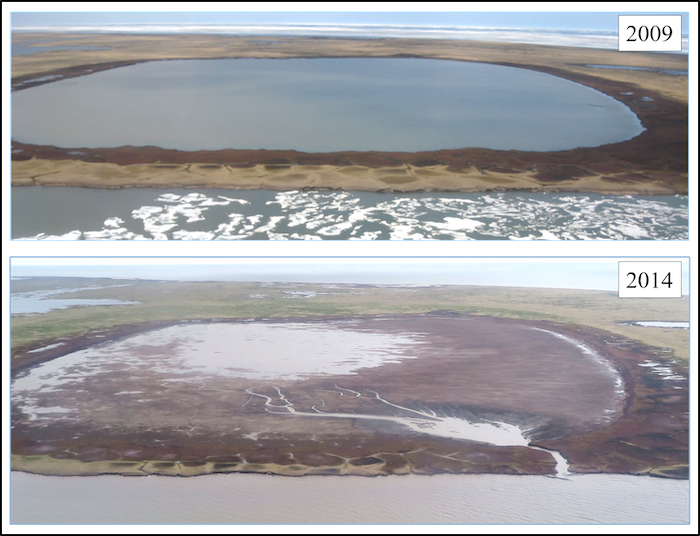
The National Science Foundation recently awarded a new grant to the University of Alaska Fairbanks (UAF), University of Wyoming, and Michigan Technological University, funding the Triple C – Permafrost Region Drained Lake Basins project
that focuses on better understanding the causes, consequences, and feedbacks between permafrost-region lake dynamics and lake drainage with an eye towards predicting future lake drainage and the myriad linkages in the Arctic System. The multi-disciplinary UAF team involves researchers from the Institute of Northern Engineering (Jones, Arp, and Kanevskiy), the Geophysical Institute (Farquharson and Larsen), and the International Arctic Research Center (Breen). Colleagues from the University of Wyoming (Parsekian, Ohara, and Rangel) and Michigan Technological University (Hinkel) round out the interdisciplinary team.
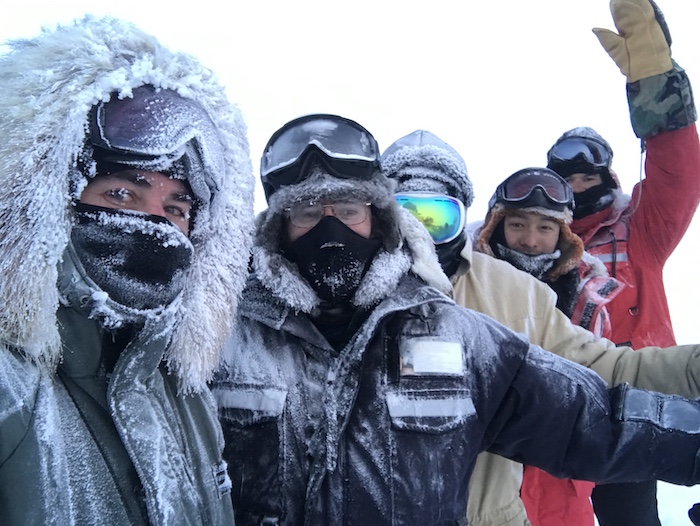
The research team recently returned from a 1,000-mile snowmachine-based expedition on the North Slope of Alaska. Six scientists began their studies in Utqiagvik (formerly known as Barrow) on 14 April and then traversed to the east, south, and west across the Arctic Coastal Plain before returning to Utqiagvik on 4 May. The focus of the first field season for the project involved instrumenting lakes and drained lake basins for water level studies, coring permafrost in drained lakes to assess permafrost aggradation following lake drainage, near-surface geophysics to quantify snowpacks and upper permafrost characteristics, and unmanned aerial vehicle (UAV)-surveys to construct three-dimensional models of the snow-covered lakes, drained lakes, and interstitial tundra environments.
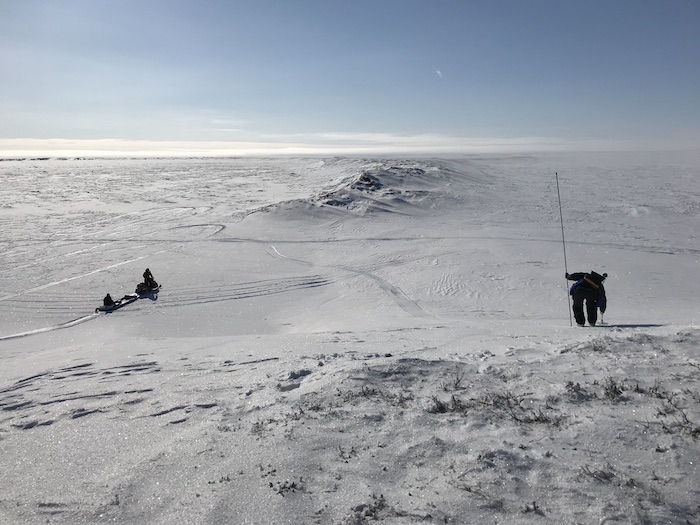
The second field campaign will occur in August 2019 where the team will be downloading field instrumentation, conducting vegetation surveys, acquiring high-resolution imagery to develop summertime digital surface models of the focus study sites, and ground-truthing a potential lake drainage product developed using geographic information systems (GIS) and remote sensing datasets (Jones et al., In Review). The team will also focus on collecting baseline data for a lake drainage manipulation experiment slated for the summer of 2020 that will provide a mechanism for observing a lake drainage event in real-time and also provide a site with which to gauge geomorphic and ecologic succession for years to come.
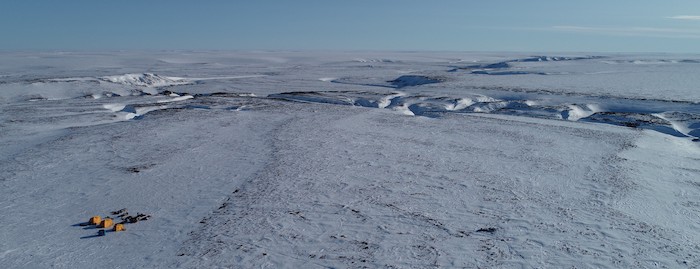
Data collected in this study will feed into future model development to enhance predictive capacity of hydrologic hazards and landscape responses to climate and land use change in the Arctic (Arp et al. In Press). The understanding of hazards and environmental processes gained from this research will advance the interests of industry, land managers, and subsistence users on the Arctic Coastal Plain of northern Alaska.
Acknowledgements
Funding for this research is provided by the National Science Foundation Arctic Systems Science program. The team thanks UIC Science and CH2MHill Polar Field Services for providing field logistics support for the project.
Further information about the project, the study design and methodological approach, related products, and members of the Catastrophic Arctic Lake Drainage Research Team is available on the Project Website.
References
Arp, C. D., B. M. Jones, K. M. Hinkel, D. L. Kane, M. S. Whitman, R. Kemnitz. In Press. Recurring outburst floods from drained thermokarst lake basins: an emerging hazard with arctic climate and land-use change. Frontiers in Ecology and the Environment.
Jones, B. M. and C. D. Arp. 2015. Observing a catastrophic thermokarst lake drainage in northern Alaska. Permafrost and Periglacial Processes 26(2):119-128. doi:10.1002/ppp.1842.
Jones, B.M., C.D. Arp, G. Grosse, I. Nitze, M.J. Lara, M.S. Whitman, L.M. Farquharson, M. Kanevskiy, A.D. Parsekian, A.L. Breen, N. Ohara, R.C. Rangel, and K.M. Hinkel. In Review. Identifying historic and future potential lake drainage events on the western Arctic Coastal Plain of northern Alaska. Permafrost and Periglacial Processes.
Nitze, I., Grosse, G., Jones, B.M., Romanovsky, V.E. and Boike, J., 2018. Remote sensing quantifies widespread abundance of permafrost region disturbances across the Arctic and Subarctic. Nature Communications, 9(1), p.5423.
Smith, L.C., Sheng, Y., MacDonald, G.M. and Hinzman, L.D., 2005. Disappearing arctic lakes. Science, 308(5727), pp.1429-1429.
Yoshikawa, K. and Hinzman, L.D., 2003. Shrinking thermokarst ponds and groundwater dynamics in discontinuous permafrost near Council, Alaska. Permafrost and Periglacial Processes, 14(2), pp.151-160.
About the Authors
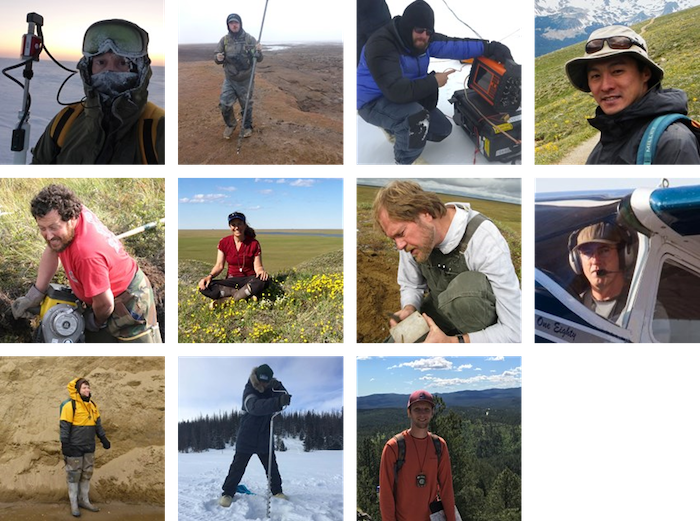
From top left to bottom right:
Chris Arp is a hydrologist at the Water and Environmental Center, Institute of Northern Engineering, University of Alaska Fairbanks.
Ben Jones is a geographer at the Water and Environmental Center, Institute of Northern Engineering, University of Alaska Fairbanks.
Andy Parsekian is a geophysist in the Department of Geology and Geophysics, University of Wyoming.
Nori Ohara is a hydrologist in the Department of Civil and Architectural Engineering, University of Wyoming.
Mikhail Kanevskiy is a geologist at the Water and Environmental Center, Institute of Northern Engineering, University of Alaska Fairbanks.
Amy Breen is a botanist at the International Arctic Research Center, University of Alaska Fairbanks.
Ken Hinkel is a geomorphologist in the Department of Geological and Mining Engineering, Michigan Technological University.
Christopher Larson is a glaciologist at the Geophysical Institute, University of Alaska Fairbanks.
Louise Farquharson is a post-doc, geomorphologist at the Geophysical Institute, University of Alaska Fairbanks.
Rodrigo Correa Rangel is a PhD student, geophysics, in the Department of Geology and Geophysics, University of Wyoming.
Ian Nichols is a MS student, hydrology, at Michigan Technological University
